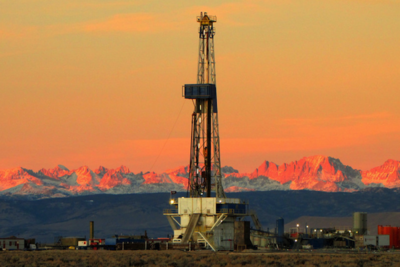Well types
| Oil Field Production Geology | |

| |
| Series | Memoirs |
|---|---|
| Part | The Production Geologist and the Reservoir |
| Chapter | Types of wells |
| Author | Mike Shepherd |
| Link | Web page |
| PDF file (requires access) | |
| Store | AAPG Store |
There are a number of different types of wells that can be drilled, and these are described below. A particular well type may be best suited or most economic in the efforts to drain a specific configuration of hydrocarbons. Various drilling strategies can be adopted to place wells in specific patterns with the aim of optimizing production from a field.
Conventional wells[edit]
In the early days of the oil industry, drilling wells was a simple operation. A well location was picked at top reservoir, and the well was drilled directly down to the target as a vertical well. Then drilling became more sophisticated when the art of deviating wells was perfected. Here, the drill bit is deflected at an angle from the vertical toward a specific target. Deviated wells are commonly drilled from fixed drilling locations such as an offshore platform.[1] One method of directional drilling uses an assembly with a mud turbine and a bit. The flow of mud through the turbine causes the attached bit to rotate while the drill string remains stationary. Drillers refer to this type of drilling as being in sliding mode because the drill pipe slides along the hole behind the turbine. To deflect the bit in the appropriate direction, a bent sub is used; this is a piece of drill pipe bent to about 1–2° angle, which is inserted behind the mud turbine and oriented from the surface along the planned direction for the well.[2]
A more recent technique for deviating a well involves using a rotary steerable assembly. Signals from the surface can be sent to the tool to deflect the bit in the appropriate direction while it is still drilling ahead in rotary mode. Drilling can be more efficient this way because there is less risk that the drill pipe will get stuck, it turns instead of slides, and the rate of penetration is faster.[3]
Vertical and moderately deviated wells are called conventional wells. They are the most common well configurations because they are relatively cheap to drill.
Sidetrack wells[edit]
A typical operation is to sidetrack a well. This is where a well has already been drilled or partly drilled and there is a need to exit out of one side of the well to a different target. A sidetrack may be required if there is an object stuck in the original hole, which cannot be fished out. In producing fields, an existing well may be sidetracked if there is no further use for that well, e.g., the oil well has watered out. A window will be cut in the casing of the original well by a special milling assembly, and drilling will then proceed out of the window toward a new target.
Horizontal wells[edit]
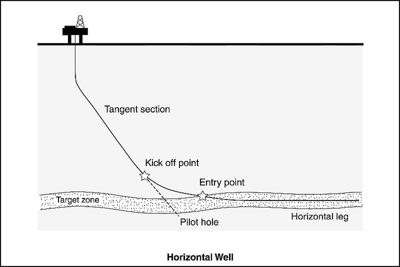
Horizontal wells are wells where the reservoir section is drilled at a high angle, typically with a trajectory to keep the well within a specific reservoir interval or hydrocarbon zone. In a strict sense, these wells are rarely perfectly horizontal, but they tend to be near horizontal mostly, generally at an angle greater than 80° from vertical.
Horizontal wells are drilled in a specific configuration. The tangent section of the well is drilled along a deviated well path to just above the reservoir section, to what is known as the kick off point. From the kick off point, the well is drilled at an increasingly higher angle, arcing around toward an angle close to horizontal. The point at which the well enters (or lands on) the reservoir is called the entry point. From there on, the well continues at a near-horizontal orientation with the intention of keeping it substantially within the reservoir target until the desired length of horizontal penetration is reached (Figure 1).
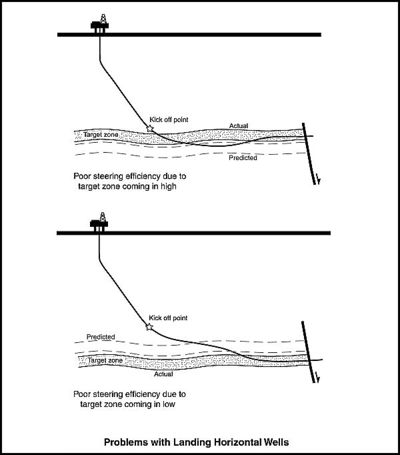
One problem in drilling a horizontal well is in locating the kick off point at about the right distance above the reservoir (Figure 2). The kick off point will be planned for a specific depth above the prognosed target zone depth, such that there will be enough room to turn the well around, so as to enter the target at a near horizontal angle. If the target zone comes in high on prediction, the chances are that the well will be drilled all the way through the reservoir before being able to turn round quickly enough to establish a horizontal trajectory. If the target zone is deeper than expected, then quite a long distance of well can be drilled at a very high angle before the reservoir is entered. Given the normal uncertainty on establishing the depth of a target zone from the seismic method, it is common for a pilot hole to be drilled first to get this information directly. Pilot holes may be vertical, although it is better to deviate the pilot hole in the direction of the horizontal well path, and closer to the planned entry point for the horizontal section. If a horizontal well is planned near an appraisal well, then this can be used as a proxy for a pilot hole.
A horizontal well can be drilled geometrically where there is a reasonable confidence in the expected reservoir geometry. The targets are defined at the entry point and at total depth, and the well is drilled according to a set geometrical plan between them.
The alternative is to geosteer a horizontal well, particularly where there is less confidence in predicting the reservoir geology. Geosteering involves using geological information obtained as the well is being drilled to try and keep the well path within the target. This can involve the use of real-time log data but may also include input while drilling from well-site biostratigraphy or from examination of drill cuttings if the lithologies at the top and base of the reservoir are distinctive.
The main technique in geosteering involves the use of a real-time log data display while the horizontal well is being drilled. The downhole log data can be directly transmitted to a computer screen in the geologist's office from the well site. This allows the geologist to establish which part of the reservoir is being drilled through and then decide where the well should be steered to next. This is done by comparing the real-time logs with data from nearby wells. Log responses in horizontal wells can look different from that in conventional wells.[5] A catalog of expected log responses, as they would appear in a horizontal trajectory, can be created by computer modeling. If the geologist thinks that the well is above the target zone, they will ask the directional driller at the rig site to steer down; if the geologist believes they are below the target, they will ask the driller to steer up.
Geosteering is at times a high-risk operation, and it can be stressful. In the early days of drilling horizontal wells, it was found that just under half of all the horizontal wells that were drilled ended up as failures or underperformed compared to expectation.[6] The record may have improved since then; nevertheless outright failures still occur today.
Frequently, when drilling new well locations, the geology will turn out quite different from what was expected and this reflects the nature of reservoir uncertainty. Even so, the outcome from the vertical penetration of a reservoir interval is a lot more predictable than when a horizontal well is drilled. Random geological uncertainties that will have a relatively trivial effect on the drilling outcome of a vertical well can cause serious problems with a horizontal well operation.
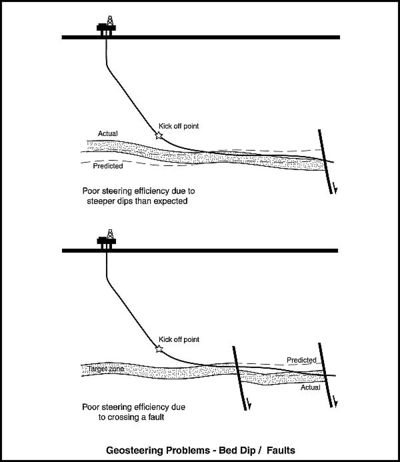
At very high angles, if the top reservoir is 15 m (49 ft) deeper than predicted, the target will be penetrated much later than planned, or maybe missed altogether (Figure 2). Sometimes, after tracking the target interval, the well may then cross an unexpected subseismic fault and exit out of the target zone. It may not be clear which stratigraphic interval has been found on the other side of the fault. The geologist monitoring the well may not know if the target is above or below the well path. Another problem that can occur is that the predicted formation dip angle is wrong by a few degrees. In this instance, the well will quickly exit out of the top or base of a thin target. It can take a long section of the drilled interval before it can be steered back into the target horizon again (Figure 3).
Some geologists refer to the steering efficiency of a horizontal well; the percentage of the total well length within the target zone beyond the entry point. Modern LWD resistivity logs used in geosteering assemblies have some degree of look-ahead capability to try and maximize the steering efficiency. The current created by the tool can have a sufficient depth of penetration to detect if the drilling assembly is converging on a bed boundary. This can give enough warning to allow the well to be steered away from the bed boundary.
Despite these problems, horizontal wells often end up as the best producers in a field. There are many reasons for drilling a horizontal well as opposed to a conventional well. They can produce considerable volumes of incremental reserves from what would otherwise be an underperforming area of the reservoir. Although they are more expensive to drill and are more prone to failure, horizontal wells often produce at several times the rate of an equivalent conventional well in the same reservoir. For example, experience in the Heavy Oil Belt of Venezuela has shown that flow rates are increased significantly by producing from horizontal wells, yet they cost only 1.5 times more than vertical wells.[7] In the Widuri and adjacent fields, offshore Sumatra, 15% of the producers are horizontal wells, yet these provide 30% of the oil production volume.[8]
Reservoirs tend to be much longer and wider laterally compared to their thickness, so a horizontal well is more likely to be in significantly greater contact with a given length of reservoir than a vertical well. Another feature of a horizontal well is that, for a given flow rate, a longer well needs less pressure drawdown to produce at that rate.
All this can create the outcome by which horizontal wells are much more productive or economic than conventional wells. This tends to be true of the following situations:
- Thin reservoirs. A conventional well will intersect a relatively thin section of the reservoir, whereas a horizontal well can run the length of the reservoir and produce much more hydrocarbons.[9]
- Horizontal wells can target long, narrow macroforms such as channel fill sandstones.
- Fractured reservoirs. A horizontal well has a much greater chance of intersecting vertical or steeply dipping natural fractures compared to conventional wells. This can be a particularly effective way of producing fractured reservoirs with very low matrix permeabilities.[10]
- Low-permeability reservoirs. Where an interval shows low permeabilities, horizontal wells can make up for this by maximizing the contact length with the reservoir. This means that low-permeability rocks such as chalk can produce at economic rates that would be marginal to uneconomic with conventional wells.
- Reservoirs prone to coning. Because of the lower drawdown, horizontal wells may be less prone to water or gas coning behavior. For example, horizontal wells have been drilled in the Widuri field, offshore Sumatra, so as to minimize water coning. High vertical permeabilities and viscous oil are factors likely to promote coning behavior in the vertical wells in the field.[8]
- Similarly, individual horizontal wells produce more oil in heavy oil reservoirs because the lower pressure drawdown tends to keep water and gas away from the well longer. For example, a total of 110 horizontal wells had been drilled prior to 2002 in the Hamaca field in Venezuela's Orinoco Heavy Oil Belt. The development plan is to ultimately drill over 1000 horizontal laterals to produce the 8–10deg API gravity oil.[11]
- Oil rims, thin oil columns typically lying below a gas cap, can be targeted with horizontal wells. The reduced drawdown minimizes the chances of coning water up from the water leg or drawing gas down from the gas cap.
In certain parts of the world, horizontal wells are the well type of preference, whereas conventional wells are much less common. This is true of the Danish North Sea, where chalk is the main reservoir interval, and also in parts of the Middle East such as Qatar, Abu Dhabi, and Oman.[12]
There are situations where it is not advantageous to drill horizontal wells. In reservoirs where there is a very low Kv/Kh because of small-scale bedding-parallel baffles, bedding-parallel horizontal wells are not effective.[13] Numerous baffles parallel to the wellbore will severely restrict the contactable drainage volume. It is better to drill strongly layered reservoirs like these with slanted instead of horizontal wells. Some subsurface professionals will advise against drilling horizontal wells if it can be more practical to drill a slant well. These are less risky to drill, and there is a better chance of establishing which part of the reservoir stratigraphy has been penetrated by the well. Slant wells may be a better option for drilling injection wells where it is important to ensure waterflood support to a specific reservoir interval.
Designer wells[edit]
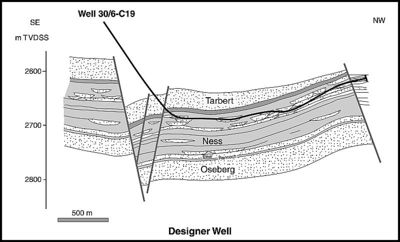
Designer wells are types of high-angle or horizontal wells that have more than one intended target. This makes them more cost effective because the individual targets would have otherwise required several conventional wells to drain them effectively. One aim of a designer well could be to penetrate and drain more than one fault block. In mature fields, multitarget infill wells can increase the chances of finding an economic volume of oil. For example, in the Oseberg field, Norwegian North Sea, a designer well successfully targeted and lined up several fluvial channel sandstone bodies (Figure 4).[14]
Multilateral wells[edit]
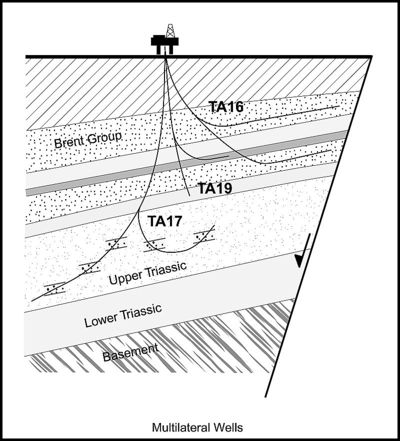
Multilateral wells are wells that have more than one branch radiating from the main borehole (Figure 5). Each branch can drain a separate part of the reservoir and produce into a common single wellbore. The advantage of multilateral wells is that, for the same number of drainage points, they can be somewhat cheaper than if separate wells had been drilled.
Coiled tubing drilling[edit]
Coiled tubing is continuous, small-diameter steel pipe stored on a reel at the surface in lengths of up to 6000 m (19,685 ft) long. Coiled tubing can be used in place of drill pipe for new wells and short-length to medium-length horizontal sidetracks (typically with a step-out of less than 800 m [2625 ft]). A mud turbine and drill bit combination is used for coiled tubing drilling. The turbine is powered by the mud moving through it; the tubing itself does not rotate. The advantage of coiled tubing drilling is that the drilling operation is quicker than normal drilling in that the connection time involved with a jointed drill pipe is eliminated. The tubing is simply rolled in and out of the well.
Through tubing rotary drilling[edit]
Through tubing rotary drilling is a relatively inexpensive method of creating a short-length to moderate-length sidetrack of an existing well (with a step-out of up to 1000 m [3381 ft], sometimes longer). Slim-bore drill pipe is used to drill the well, and the benefit of this is that the drill pipe is narrow enough to be run through the existing production tubing.[16] This eliminates the time and cost involved with pulling the completion in an existing well to start drilling and then rerunning it after the well has reached total depth. Through tubing rotary drilling has been used in the Gullfaks field in the Norwegian North Sea. 4-D seismic data is used to identify remaining oil targets. Many of these targets are small but can be drilled cheaply by the use of through tubing rotary drilling. This has contributed to a reversal of the oil production decline at the late mature stage of field life.[17]
References[edit]
- ↑ Cheatham, C., 1992, Wellbore trajectory, in D. Morton-Thompson and A. M. Woods, eds., Development geology reference manual: AAPG Methods in Exploration Series 10, p. 71-75.
- ↑ Inglis, T. A., 1987, Directional drilling: London, Graham & Trotman, 260 p.
- ↑ Downton, G., A. Hendricks, T. S. Klausen, and D. Pafitis, 2000, New directions in rotary steerable drilling: Oil-field Review, Spring 2000, v. 12, no. 1, p. 18-29.
- ↑ 4.0 4.1 4.2 Shepherd, Mike, 2009, Types of wells, in M. Shepherd, Oil field production geology, AAPG Memoir 91, p. 231-297.
- ↑ Meehan, D. N., 1994, Geological steering of horizontal wells: Journal of Petroleum Technology, SPE 29242, v. 46, no. 1, p. 3-12.
- ↑ Beliveau, D., 1995, Heterogeneity, geostatistics, horizontal wells, and blackjack power: Journal of Petroleum Technology, v. 47, no. 4, SPE Paper 30745, p. 1068-1074.
- ↑ Hamilton, D. S., R. Barba, M. H. Holtz, J. Yeh, M. Rodriguez, M. Sanchez, P. Calderon, and J. Castillo, 2003, Horizontal-well drilling in the heavy-oil belt, eastern Venezuela Basin: A postmortem of drilling experiences, in T. R. Carr, P. Mason, and C. T. Feazel, eds., Horizontal wells: Focus on the reservoir: AAPG Methods in Exploration 14, p. 127-141.
- ↑ 8.0 8.1 Carter, D. C., W. Kortlang, M. Smelcer, and J. C. Troncoso, 1998, An integrated approach to horizontal well design and planning in Widuri field, offshore southeast Sumatra, Indonesia: Proceedings of the Indonesian Petroleum Association, 26th Annual Convention, May 1998, v. 2, p. 135-162.
- ↑ Fayers, F. J., S. Arbabi, and K. Aziz, 1995, Challenges in reservoir engineering from prospects for horizontal wells: Petroleum Geoscience, v. 1, p. 13-23.
- ↑ Major, R. P., and M. H. Holtz, 1997, Identifying fracture orientation in a mature carbonate platform reservoir: AAPG Bulletin, v. 81, no. 7, p. 1063-1069.
- ↑ Tankersley, T. H., and M. W. Waite, 2002, Reservoir modeling for horizontal exploitation of a giant heavy oil field-Challenges and lessons learned: Presented at the SPE International Thermal Operations and Heavy Oil Symposium and International Horizontal Well Technology Conference, November 4-7, 2002, Calgary, Canada, SPE Paper 78957, 6p.
- ↑ Nurmi, R., Horizontal highlights: Middle East Well Evaluation Review, no. 16, p. 8-25.
- ↑ Haldorsen, H. H., D. M. Chang, and S. H. Begg, 1987, Discontinuous vertical permeability barriers: A challenge to engineer and geologists, in J. Kleppe, E. W. Berg, A. T. Buller, O. Hjelmeland, and O. Torsaeter, eds., North Sea oil and gas reservirs I: London, Graham & Trotman, p. 127-151.
- ↑ 14.0 14.1 Ryseth, A., H. Fjellbirkeland, I. K. Osmundsen, Å. Skålnes, and E. Zachariassen, 1998, High-resolution stratigraphy and seismic attribute mapping of a fluvial reservoir: Middle Jurassic Ness Formation, Oseberg field: AAPG Bulletin, v. 82, no. 9, p. 1627-1651. Reprinted with permission from the AAPG.
- ↑ Black, R. C., H. J. Poelen, M. J. Roberts, and S. E. Roddy, 1999, Tern field development: A marriage of new technologies for business benefit, in A. J. Fleet and S. A. R. Boldy, eds., Petroleum geology of northwest Europe: Proceedings of the 5th Conference, Geological Society, London, p. 1063-1073.
- ↑ Reynolds, H. and G. Watson, 2003, String design and application in through-tubing of rotary drilling (TTRD): Presented at the SPE Latin American and Caribbean Petroleum Engineering Conference in Port-of-Spain, April 27-30, 2003, Trinidad, SPE Paper 81096, 14 p.
- ↑ Todnem, A. C., L. Arnesen, and R. Gaasø, 2005, 4D seismic and through tubing drilling and completion wells extend life on the Gullfaks field: Presented at the SPE/International Association of Drilling Contractors Drilling Conference, February 23-25, Amsterdam, Netherlands, SPE Paper 92551, 10 p.
